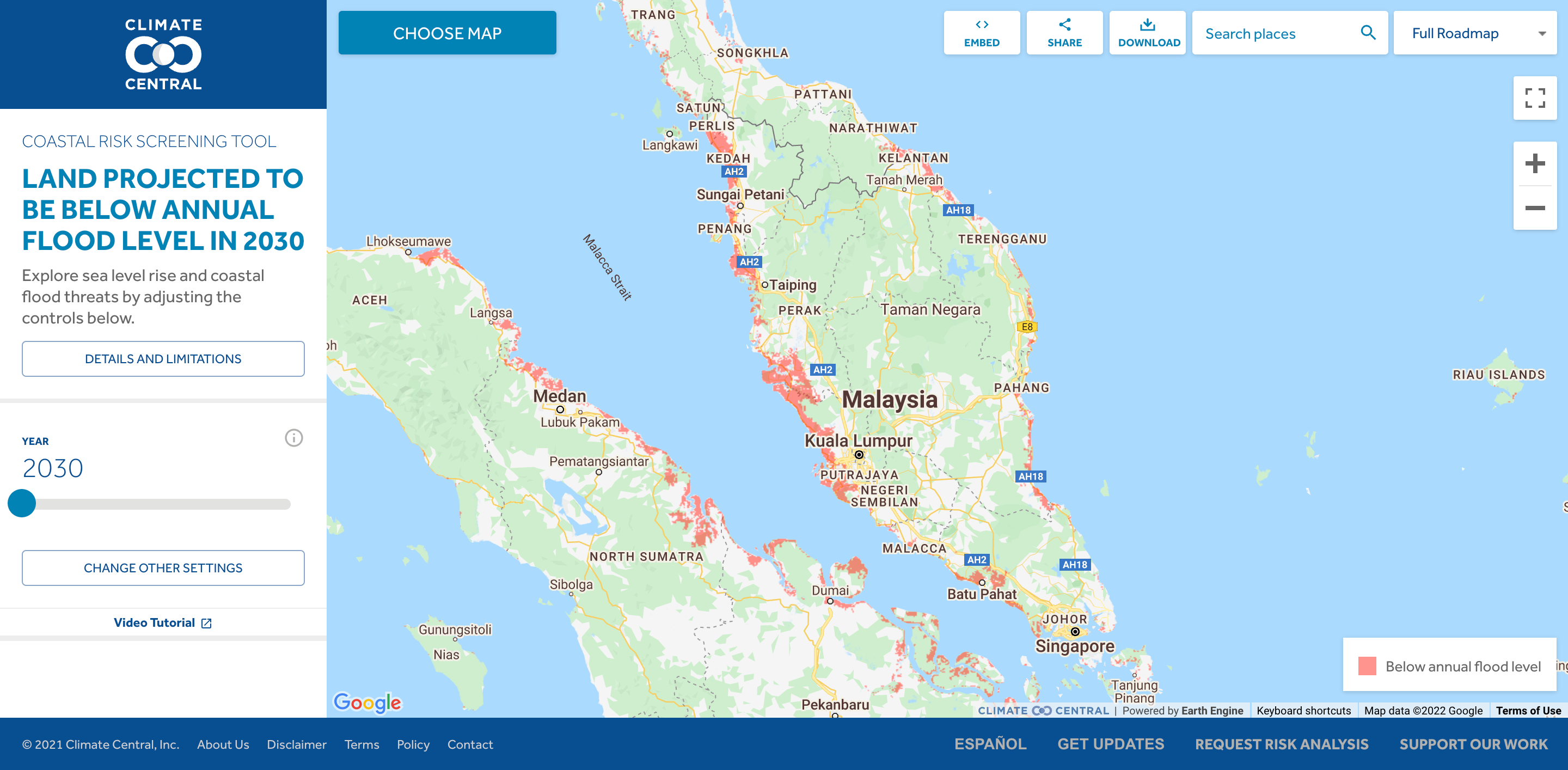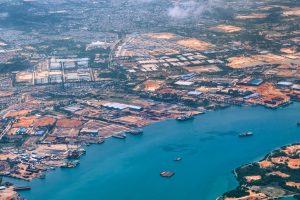When Malaysia’s Prime Minister Ismail Sabri Yaakob met with his Thai counterpart Prayut Chan-o-cha in late February in Bangkok to discuss, among other things, closer crossborder ties, the two leaders might also have considered coordinating efforts to address the deleterious impact of rising sea levels on their vulnerable coastlines and inland areas.
Predictions about when coastlines will be threatened by rising oceans and by exactly how many millimeters seas in Southeast Asia will rise may be rough, but it’s safe to assume, based on new evidence that initial estimates put forward by the U.N.’s Intergovernmental Panel on Climate Change (IPCC) in 2007 were grossly underestimated.
Back then climate science was just finding its footing. For instance, the IPCC’s 2007 Special Report on Emission Scenarios estimated that in the 20th century, global average sea level rose at a rate of about 1.7 millimeters per year. It also initially concluded that by the mid-2090s, global sea levels would rise to 0.22 to 0.44 meters above 1990 levels – or around 4 millimeters per year, about twice 20th-century levels. Those estimates were worrisome but not catastrophic.
Importantly, the authors acknowledged that “thermal expansion” would contribute to more than half of the rise; it also forecast that “land ice will lose mass increasingly rapidly as the century progresses.” This is the red warning light that has been flashing worldwide ever since. Yet the projections of exactly how high sea levels will rise have been the subject of some speculation.
That is, until now.
Those who wrote the 2007 IPCC report conditioned their estimates about the rapidity of sea rise by stating that “an important uncertainty relates to whether [the] discharge of ice from the ice sheets will continue to increase as a consequence of accelerated ice flow.”
In 2018, a study published in Science Advances determined that “freshwater melting of glaciers in some regions of Antarctica caused a layer of cold, freshwater to float above warmer, saltier water, both slowing ocean circulation and melting lower parts of the ice sheets.”
Here the authors describe the so-called “feedback loop,” which posits exactly that: that the underbellies of the Antarctic’s vast ice shelves are being exposed to this warmer water and melting more quickly as a result.
This, of course, leads to the ice shelves eventually breaking away from the frozen mainland, which, in turn, exposes the mainland ice to liquefaction. This then will result in rapid – and aggressive – sea level rises that will have a devastating impact on the low-lying coastlines of many nations, including Thailand and Malaysia.
Then, in 2019, Climate Central issued a report stating that over the course of the 21st century, “global sea levels are projected to rise between about 2 and 7 feet… and possibly more.” It further noted that the threat was “concentrated in coastal Asia and could have profound economic and political consequences within the lifetimes of people alive today.”
Climate Central’s interactive threat maps forewarn unimaginable levels of coastal flooding in Thailand and Malaysia between 2030 and 2050. The Thai capital Bangkok, it is predicted, will be more or less submerged as global sea levels rise, given that it sits only 1.5 meters above sea level in the Gulf of Thailand.
Below are Climate Central’s most updated projections, made on February 28, which forecast the severe flooding in Bangkok and along Malaysia’s coastlines that is now projected to occur as soon as 2030.


Almost certainly, between 2030 and 2050, peninsular Malaysia’s western and eastern shores will be inundated by the waters of the Malacca Straits and the South China Sea, perhaps submerging as much as 12,000 square kilometers of coastal property, or up to 1.7 million hectares of agricultural and urban landmass.
These losses would be truly devastating.
But back to the latest science. In 2021, scientists presenting before the American Geophysical Union said they anticipated that within the next five to ten years the Thwaites Glacier in Western Antarctica will collapse, much earlier than expected. According to the scientists, the Thwaites Glacier is a behemoth: one of Antarctic’s largest glaciers, about the size of Florida. They maintain that its meltwater “alone is responsible for 4 percent of global sea level rise.”
According to an article published by Columbia Climate School, if the Thwaites Glacier were to dissolve, “then global sea levels would rise by 65 centimeters or about two feet.” If, however, not only the Thwaites Glacier but also several of the surrounding glaciers, including Pine Island Glacier, melt and “cannot hold back the West Antarctic Ice Sheet, which holds the equivalent of 3.3 meters (10.8 feet) in sea level, then it could affect coastlines across the world.”
In other words, Thailand and Malaysia can reasonably expect to begin to experience the catastrophic impact of sea rise starting in the early 2030s. And depending on whether or not global temperatures are kept below the target level of 1.5 degrees, these levels could rise dramatically going forward.
Accordingly, it makes sense for the two countries to partner on ways to combat their mutual vulnerabilities. How could they prepare?
One idea to consider is building national networks of coastal sea walls or dykes to fend off the menacing rising tides. Certainly, Bangkok will need defending, with over 120 kilometers of low-lying southern shoreline. But also Malaysia, which has up to 1,000 kilometers of low-lying coastlines exposed to rising seas.
There is a precedent for this. In 1530, a storm surge wiped out nearly 100,000 people living in the Netherlands after overrunning an early system of dykes and storm surge barriers. Since then, the low-lying European nation has had hundreds of years of experience building coastal barriers to hold back the powerful forces of Mother Nature.
Another idea, gaining currency in the Netherlands, is to use more natural solutions to protect against the hazards of impending sea rise. The Dutch are experimenting with a solution they call “De Zandmotor” or “sand motor.” This would involve the creation of huge peninsulas composed of sand to help keep the sea at bay and away from coastlines and local cities. In appropriate places, “sand motors” could contribute to a wholesale solution for both Malaysia and Thailand.
Whatever these two important Southeast Asian countries decide to do to protect their people, they need to begin planning a steady course of action. The science is irrefutable. The tides will not wait. The sea is rising. They can hope for the best, but need to prepare for the worst.

































